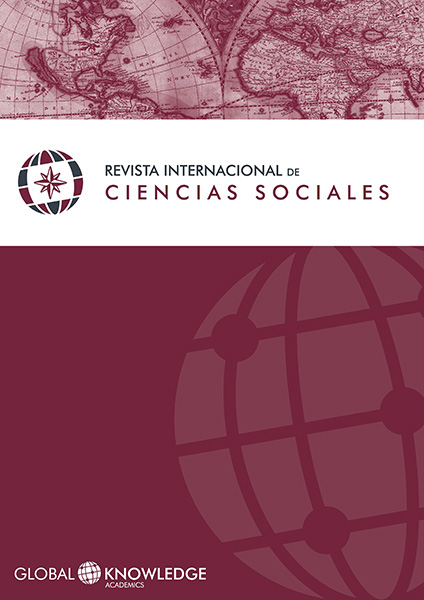Portuguese Customers Trust in Banks Evolution
DOI:
https://doi.org/10.37467/gka-revsocial.v8.2052Keywords:
Banking, Bank account, Customer satisfaction, Loyalty, Trust, Economic behaviour, Economic crisisAbstract
The analysis of the behaviour of bank customers has been considered in recent years with great interest by the international banking sector and gained greater relevance during the economic and social crisis that began between 2007 and 2008. In this study, it is demonstrated that, currently, the element most relevant to customer satisfaction and loyalty in relation to its main bank in Portugal is trust. But there is a significant shift in banking activity, with a very different approach from what we have traditionally known, which could lead to a further decline in long-term customer trust.
Downloads
Global Statistics ℹ️
|
447
Views
|
163
Downloads
|
|
610
Total
|
|
References
ADAMSON, I.; CHAN, K.M.; HANDFORD, D. (2003). Relationship marketing: customer commitment and trust as a strategy for the smaller Hong Kong corporate banking sector. International Journal of Bank Marketing, vol. 21, n. 6/7, p. 347-358. DOI: https://doi.org/10.1108/02652320310498492
ANDERSON, E.W.; WEITZ, B. (1989). Determinants of continuity in conventional industrial channel dyads. Marketing Science 8 (4), p. 310-323. DOI: https://doi.org/10.1287/mksc.8.4.310
ANDERSON, J. C; GERBING, D.W. (1988). Structural Equação Modelling in Practice: A Review and Recommended Two-Step Approach. Psychological Bulletin, VoI.103, N°3, pp. 411-423. DOI: https://doi.org/10.1037/0033-2909.103.3.411
BERRY, L.L. (1995). Relationship marketing of services: growing interest, emerging perspectives. Journal of the Academy of Marketing Science, vol. 23, n. 4, p. 236-245 DOI: https://doi.org/10.1177/009207039502300402
BERRY, L.L. (2002). Relationship marketing of services: perspectives from 1983 and 2000. Journal of Relationship Marketing, vol. 1, n. 1. DOI: https://doi.org/10.1300/J366v01n01_05
BHATTACHERJEE, A. (2002). Individual Trust in Online Firms: Scale Development and Initial Test. Journal of Management Accounting Research, 19 (1), pp. 211–241. DOI: https://doi.org/10.1080/07421222.2002.11045715
COLEMAN, James S. (1988). Social Capital in the Creation of Human Capital. American Journal of Sociology, vol. 94: 95-120. DOI: https://doi.org/10.1086/228943
COOPER, A.C.; WOO, C.Y.; DUNKELBERG, W.C. (1988). Entrepreneurs’ perceived chances for success. J. Business Vent. 3, 97 – 108. DOI: https://doi.org/10.1016/0883-9026(88)90020-1
CROSBY, L.A.; EVANS, K.R.; COWLES, D. (1990). Relationship Quality in Services Selling: An Interpersonal Influence Perspective. Journal of Marketing, 54 (July), 68-81. DOI: https://doi.org/10.1177/002224299005400306
DAMÁSIO, António R.; BECHARA, Antoine (2005). The somatic marker hypothesis: A neural theory of economic decision. Department of Neurology, University of Iowa, 200 Hawkins Drive, Iowa City, IA 52242, USA.
DWYER, F.; SCHURR, P; OH, S. (1987). Developing buyer-seller relationships. Journal of Marketing, vol. 51, April, p. 11-27. DOI: https://doi.org/10.1177/002224298705100202
GANESAN, S. (1994). Determinants of Long-Term Orientation in Buyer-Seller Relationship. Journal of Marketing, 58: April,1-19. DOI: https://doi.org/10.1177/002224299405800201
GUILLEMETT, Yvan, TURNER, David (2018). The Long View: Scenarios for the World Economy to 2060, OECD Economic Policy Papers, nº 22, July, OECD Publishing, Paris.
HAIR Jr., J. F.; ANDERSON, R.E.; Tatham, R. L.; BLACK, W. C. (2005). Análise multivariada de dados. 5 ed., Porto Alegre: Bookman, 2005.
HENNIG-THURAU, T.; GWINNER, K. P.; GREMLER D. D. (2002). Understanding Relationship Marketing Outcomes: An Integration of Relational Benefits and Relationship Quality. Journal of Service Research, 1, 4(3), p. 230 – 247. DOI: https://doi.org/10.1177/1094670502004003006
JOHNSTON, J. (1984). Econometric Methods, McGraw-Hill, 3rd Edition, 1984.
JONES, T. O.; SASSER Jr., W.E. (1995). Why Satisfied Customers Defect. Harvard Business Review. 73 (6), pp. 88-99.
KAHNEMAN, Daniel (2011). Thinking Fast and Slow. New York: Farrar, Straus and Giroux, pp. 281.
KAHNEMAN, Daniel; KNETSCH, Jack; THALER, Richard (1991). Anomalies: The Endowment Effect, Loss Aversion, and Status Quo Bias. The Journal of Economic Perspectives, Vol. 5, No. 1. (Winter, 1991), pp. 193-206. DOI: https://doi.org/10.1257/jep.5.1.193
KAHNEMAN, Daniel; TVERSKY, Amos (1979). Prospect Theory: An Analysis of Decision under Risk. Econometrica, Volume 47, Issue 2 (Mar., 1979), 263-292. DOI: https://doi.org/10.2307/1914185
KOTLER, P.; ARMSTRONG, G. (1998). Princípios de Marketing. 7ª ed., Livros técnicos e Científicos Editora S.A., Rio de Janeiro.
KOTLER, Philip (1998). Administração de Marketing: análise, planejamento, implementação e controle. 5ª edição, São Paulo: Atlas, 1998.
KOTLER, Philip (2000). Administração de Marketing: A Edição do Novo Milénio. Prentice Hall. São Paulo.
LANCASTER, Kelvin J. (1966). A New Approach to Consumer Theory. The Journal of Political Economy, Vol. 74, No. 2 (Apr., 1966), pp. 132-157. University of Chicago Press. DOI: https://doi.org/10.1086/259131
LISACK, Noemie, SAJEDI, Rana, THWAITES, Gregory. Demographic trends and the real interest rate, Bank of England, Staff Working Paper No. 701, December.
LOEWENSTEIN, George; RICK, Scot (2008). The Role of Emotion in Economic Behavior, Risk Management and Decision Processes Center. The Wharton School, University of Pennsylvania, 2008.
MOORMAN, C.; ZALTMAN, G.; DESHPANDE, R. (1992). Relationships between providers and Users of market research: the dynamics of trust within and between organizations. Journal of Marketing Research, vol. 29. DOI: https://doi.org/10.1177/002224379202900303
MORGAN, R. M.; HUNT, S. D.(1994). The commitment-trust theory of relationship marketing. Journal of Marketing, vol. 58, n. 3, p. 20-38. DOI: https://doi.org/10.1177/002224299405800302
OLIVER, R. L. (1999). Whence consumer loyalty?. Journal of Marketing, vol. 63, Special Issue, p.33-44, 1999. DOI: https://doi.org/10.1177/00222429990634s105
REICHHELD, F. F. (1994). Loyalty and the renaissance of marketing. Marketing Management, vol. 2, n. 4, p. 10-17
RICH, M. (2000). The Direction of Marketing Relationships. Journal of Business & Industrial Marketing, Vol. 15, Nº 2/3, pp. 170-179. DOI: https://doi.org/10.1108/08858620010316877
SAMUELSON, William; ZECKHAUSER, Richard (1988). Status Quo Bias in Decision Making. Journal of Risk and Uncertainty, I (1988), 7–59. DOI: https://doi.org/10.1007/BF00055564
SEN, Amartya (2004). How does culture matter? in Culture and Public Action, Edited by Vijayendra Rao and Michael Walton, Stanford University Press, Stanford, California, 2004.
SILVA, J. M. Amado da (1991). Economia Industrial e Excesso de Capacidade. Coleção Estudo Geral Instituto de Novas Profissões.
SIRDESHMUKH, D.; SINGH, J.; SABOL, B. (2002). Consumer trust, value, and loyalty in relational exchanges. Journal of Marketing, vol. 66, January, p. 15-37. DOI: https://doi.org/10.1509/jmkg.66.1.15.18449
SIVASUBRAMANIAN, Srinivasan, JACOB, Lincy (2018). Retail banking trends for Australia, Infosys Limited External document, White Paper.
THALER, Richard H.; HERSH M. Shefrin (1981). An Economic Theory of Self-Control. Journal of Political Economy, 89 (2), 392-410. DOI: https://doi.org/10.1086/260971
TVERSKY, Amos; KAHNEMAN, Daniel (1981). The framing of decisions and the psychology of choice. Science, v.211, January 1981. DOI: https://doi.org/10.1126/science.7455683
YAMAGISHI, Toshio; COOK, Karen; WATANABE , Motoki (1998). Uncertainty, trust and commitment formation in the United States and Japan. American Journal of Sociology, 104, 165–94. DOI: https://doi.org/10.1086/210005
Downloads
Published
How to Cite
Issue
Section
License
Those authors who publish in this journal accept the following terms:
-
Authors retain copyright.
-
Authors transfer to the journal the right of first publication. The journal also owns the publishing rights.
-
All published contents are governed by an Attribution-NoDerivatives 4.0 International License.
Access the informative version and legal text of the license. By virtue of this, third parties are allowed to use what is published as long as they mention the authorship of the work and the first publication in this journal. If you transform the material, you may not distribute the modified work. -
Authors may make other independent and additional contractual arrangements for non-exclusive distribution of the version of the article published in this journal (e.g., inclusion in an institutional repository or publication in a book) as long as they clearly indicate that the work was first published in this journal.
- Authors are allowed and recommended to publish their work on the Internet (for example on institutional and personal websites), following the publication of, and referencing the journal, as this could lead to constructive exchanges and a more extensive and quick circulation of published works (see The Effect of Open Access).













